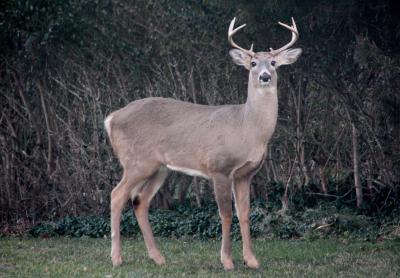Deer Harvest Is Down

The weather has been exceptionally good for January. Cold and deep snow are not a problem. The deer herd throughout East Hampton appears to be bigger than ever. Why then, two weeks into the annual monthlong deer-hunting season for gunners, has the harvest been so low?
Hunters who bag a deer in Montauk must take it to the State Department of Environmental Conservation’s check station on Old Montauk Highway. Yesterday, the check station reported that only 12 deer had been taken from the woods at Hither Hills State Park, and 7 from Montauk Point State Park.
Meanwhile, during the same two-week period, there were 14 deer killed by vehicles within the boundaries of East Hampton Town. Between January of 2011 and January of this year, state workers have picked up 231 dead deer along state roads on the South Fork. The D.E.C. has not yet tallied the harvest of deer during the archery season that ended on Dec. 31.
Experts say there may be a simple explanation for the low numbers. The short answer is, deer are not being taken in the woods because they’re not in the woods. An answer to how best to keep a lid on the expanding population of whitetail deer is not so easy.
“They’re in everybody’s backyard. They’re not stupid, that’s why the herd is so big,” said Steven Tekulsky, a member of the recently formed East Hampton Sportsmen’s Alliance. The group was organized to help the town and individual neighborhoods control the herd through education and, if need be, by obtaining state-issued “nuisance” hunting permits that allow hunters to cull deer from private properties and communities.
Why deer have abandoned the forest in favor of human turf is not difficult to understand, Larry Penny, the town’s director of natural resources, said on Tuesday.
“It’s a bad acorn year,” he said of the deer’s favorite, high-protein forage food. “And, they’re competing with wild turkeys on the ground. They prefer nice landscaping, junipers, arborvitae to twigs and buds. Browse is not their favorite food. There’s lots of green stuff in residential areas, and they’re safe there. Some now live there permanently” — no surprise to the town’s human population.
Terry O’Riordan, one of the founders of the sportsmen’s alliance, said, “I agree that the acorn shortage is a factor. Turkeys may be the next new vermin, as far as our woods and forests are concerned.”
Hunting is still considered to be the most efficient and cost-effective way to cull deer herds. Population is managed y manipulating the mortality rates of adult female deer. According to the D.E.C., the job has become more difficult in recent years because of a 40-percent reduction in the amount of hunting activity since the mid-1980s.
The D.E.C. also reports that more troubling is the fact that lands that are closed to hunting or that get only nominal hunting pressure function as refuge areas for deer. This frustrates the D.E.C.’s ability to manage deer numbers to levels that are acceptable to the public. Compounding the problem are people who feed the deer, which is a violation of state law.
“Frequently this results in locally abundant deer populations that negatively impact forests, create problems for homeowners and motorists, and may decrease the value attributed to deer by the affected public,” a section of the conservation agency’s deer management policy says. “Hunting remains the first choice and most cost-effective option for controlling deer populations.”
The agency also has a mandate to accommodate the state’s half-million hunters who, in addition to thinning the herds by approximately 200,000 deer each year, also produce 11 million pounds of high-quality meat.
Hunting may be the most effective means, but it remains distasteful and inhumane to some. Bill and Ellen Crain of the East Hampton Group for Wildlife staged a three-day hunger strike to dramatize their concern at the start of this year’s hunting season.
Councilman Dominick Stanzione is spearheading the Deer Management Working Group, an effort to come up with a comprehensive management plan for the East End in cooperation with government and nongovernment land managers, including the Peconic Land Trust, the Nature Conservancy, and county and state parks departments.
Mr. Stanzione said local hunters were doing as much as they could do. “We need a more comprehensive, compassionate, and effective deer-management plan. We have an inclusive committee of about 19 members, a real cross-section, hunters as well as those favoring nonlethal approaches.” He said the committee was also receiving suggestions from the federal Department of Agriculture, which is involved in deer management up and down the East Coast.
Mr. Stanzione said he expected to present a draft version of the management plan to town board members within a week or two.
